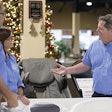
If you live in places like Southern California or the Houston area or Denver, then you know the sky can also be brown. Or a queasy shade of yellow. And that's because, in spite of the fact that industry and government have made enormous strides in reducing air pollution since the Clean Air Act was amended in 1970, the combination of weather patterns, dense population and topography leaves certain parts of the country under a black cloud - literally.
While the states have borne the responsibility for meeting the federal clean air standards for the past 40 years, recently some states have become more proactive in setting tougher standards. The New York Times reported in late August on a draft proposal by nine Northeastern states to cut power plant emissions in the region. Environmental groups have praised the unprecedented cooperative action as an example for other states. The Times reported that California, Washington and Oregon are exploring a similar agreement.
While pool heaters collectively contribute only a tiny fraction of the country's air pollution - they are both small and infrequently operated compared to other sources - by complying with regulations in two of the jurisdictions with the most intractable air-quality problems, pool and hot tub industry manufacturers are doing their part to keep skies clear and the air healthy across the United States.
States and air-quality districts continually review how they keep their air clean and healthy. In fact, the region in California that has a rule specifically regulating pool heaters is currently revising that rule and will implement any changes by the end of the year. As states look closely at how to reach their goals, it's useful to know what the pool industry has done and is doing to play its part.
Clean Air History
The Clean Air Act first passed in 1963, and amendments in 1970 form the foundation of today's federal air-quality control. Further major amendments in 1990 gave us the Clean Air Act that governs air quality today. According to the Environmental Protection Agency's Air Quality Planning & Standards office, the EPA sets the limits on air pollution by setting federal standards on six principal air pollutants, called the criteria pollutants. The states must create State Implementation Plans to meet the federal standards. The SIP, which must be approved by the EPA, is a collection of the regulations a state will use to meet its air-quality goals. The states must involve the public, through hearings and opportunities to comment, in the development of each state implementation plan.
While critics say that it hasn't gone far enough, the Clean Air Act has been pretty successful by the EPA's own measures. According to the executive summary of the EPA's 2003 National Air Quality and Emissions Trends Report, a comparison of emissions in 2002 with emissions in 1970 shows improvement in each of the six criteria pollutants: carbon monoxide (CO) is down 48 percent; volatile organic compounds (VOC), a contributor to ozone, are down 51 percent; sulphur dioxide (SO2) is down 52 percent; particulate matter (PM) is down 34 percent and lead (Pb) is down 98 percent. But nitrogen oxides (NOx) are down only 17 percent. And that brings us to the swimming pool industry and pool heaters in particular.
While the EPA says that mobile sources like cars, buses and trucks contribute the most NOx pollution (about half), and utilities like coal-burning power plants contribute about one quarter, other sources - the category that includes residential gas-burning appliances like pool heaters - contribute the remaining quarter.
Who Decides?
Of course, states have concentrated on the biggest sources of pollution first; the vehicles you drive and the fuels you burn are many, many times cleaner than they were in 1970. And utilities have made improvements in their emissions, too. But even after all these changes, some jurisdictions still have critically unhealthy air. And at least two of them, the South Coast region of California and the state of Texas, decided to regulate smaller sources of pollution.
"We in the South Coast, along with the San Joaquin valley, have the worst air quality in the nation. The Houston area is a close competitor," says Laki Tisopulos, assistant deputy executive officer/planning and rule development for the South Coast Air Quality Management District (SCAQMD). "As a result, we are obligated to adopt and implement the most-stringent and aggressive regulations to bring the region into attainment with standards.
"We looked at both stationary and mobile sources, and there's no silver bullet. You could shut down the entire industry, and we will still be in nonattainment here in Southern California. Basically, our long-range plans, the Air Quality Management Plans, demonstrate that we need and we ought to reduce emissions from each and every source category. We have to push the technologies to the limit, and even that is not good enough. Often we have to rely on technological evolutions that are in the future to really allow us to get to attainment."
The SCAQMD has jurisdiction over Los Angeles, Orange, San Bernardino and Riverside counties. Its rule 1146.2, adopted in 1998, governs large water heaters and small boilers, the category that includes most pool heaters. The current rule limits NOx emissions to 55 ppm on heaters from 75,000 to 400,000 Btu. The agency, which has a board made up of 12 elected and appointed officials, has rule-making, implementation and enforcement power.
"Staff does all the technical analysis, namely the feasibility analysis, the technical-feasibility analysis, the cost-feasibility analysis," says Tisopulos. "We work very closely through a working group set up with the stakeholders, which typically are manufacturers, and often we have representatives from the end-users as well. Then, once we have a formal proposal, we conduct public workshops and consultation meetings where we invite broader impacted entities, as well as the general public, to those meetings. We solicit comments, and make appropriate changes that may be necessary and ultimately, once we sort this all out, we present that to our governing board." If the board approves the proposal, it goes into effect.
The rule-making staff makes recommendations that represent volumes of research. They must carefully balance the benefits of a rule with its cost. "Typically we look at two things: What is available in terms of technology, and how low can we go - what is the technological feasibility of a particular proposed limit," says Tisopulos. "Once we figure that out, then we try to address a second question, and that is, 'At what cost?' And we have to strike a balance between those two. Because if money is not an issue, you can go as low as you want. But money is always an issue!"
But technology is not the only consideration for the rules and planning group. "We do conduct a detailed socioeconomic analysis," says Tisopulos. "Because we want make sure that we improve air quality here in the basin, but want to know the economic impact a particular regulation will have, and obviously we want to select alternatives that minimize those impacts. We can never run away from those impacts, but we want to minimize them."
Industry Response
While it's unusual to find an industry that welcomes regulation, pool heater manufacturers seem to have adjusted - and even thrived - over the past half-dozen years or so that low-NOx regulations have been in effect in Southern California and Texas. (The Texas Commission on Environmental Quality adopted a similar NOx emissions rule in 1999.)
"As we all kind of had to dive in at once, most manufacturers had some ups and downs with the product," says Peter Owenson, product manager for Jandy. "But I think pretty much everybody has their product on line now."
In order to meet the California requirements, manufacturers had to reduce their NOx emissions by half or more. Wayne Barcikowski, Air Quality Specialist for the SCAQMD, says research indicated an average NOx output of 110 to 130 ppm in unregulated atmospheric heaters and set the limit at 55 ppm. Gary Quinn, program supervisor at the SCAQMD, says, "The regulation has reduced the amount of NOx emitted by this category by 5 tons per day."
Manufacturers achieved this pollution savings in slightly different ways, but the key is in controlling combustion.
"You seal up the combustion and you only let a metered amount of oxygen in," says Jandy's Owenson. "Whether you do that by the venturi effect or with a blower, it's just really controlling the volume of excess oxygen that allows you to tune in the emissions."
At RayPak, the low-NOx heater uses a more sophisticated burner and has a fan. "NOx is formed by a hot flame that bonds the oxygen with the nitrogen. The way you lower those emissions is to have a cooler flame," says Terry Doyle, pool product manager at RayPak. "One of the ways to do that is with a lot of small flames. In our regular atmospheric heater, that flame will burn 6 to 7 inches high. In a low NOx, it's in the 2-inch range."
The Hayward low-NOx unit also achieves the emissions requirement by controlling the burn. "It's got a different burner, and the speed at which it moves air through the firebox is very important, as is the air-to-gas ratio," says John Ott, a technical services representative at Hayward.
With just two jurisdictions requiring low-NOx heaters, it would be reasonable to assume that the category doesn't have a big impact on bottom lines. But the percentage of sales that come from low-NOx heaters ranges from 100 percent (all of Sta-Rite's heaters are low-NOx) to approximately 25 percent. Some companies have specific model lines that are low-NOx while others have versions of their regular heaters for distribution in Southern California and Texas.
Although the low-NOx units are somewhat more expensive to manufacture (estimates ranged from 7 percent up to 20 percent), they may have some unforeseen benefits aside from the intended benefit of cleaner air.
"The low-NOx heater has made a lot of inroads into areas that do not have the low-NOx requirement," says Ott. "One of the things that [the low-NOx heater] does is it manages wind situations very well.
"If you have a situation where the wind can blow down on top of the heater, you have down-drafting which can damage the inside of the heater. With the low-NOx heater that has a fan, you have a positive pressure pushing out of the top of the heater and it eliminates any down-drafting problems." Ott says that Hayward's sales in the Las Vegas area, which has a significant wind problem, are almost entirely low-NOx models.
And as consumers become more and more aware of air quality issues, some manufacturers are getting more calls directly from consumers inquiring about low-emission options for equipment.
"We get calls all the time from environmentally concerned consumers who might say, 'Well, if I have the choice, I want to do something good,'" says Doyle. "And they really get into it. They want to know: 'What's the difference between this one and a regular heater? Am I making a difference? If I am, I'm willing to pay.' They don't care about the money."
Ott also finds consumers are getting more involved in the details of what goes into their pools. "Consumers are becoming more and more savvy. I think we're seeing more and more second-time pool owners, people are becoming more involved in the full purchase rather than letting the contractor do it all," he says. "That's growing steadily. In the last year I've gotten more calls from homeowners questioning the equipment being put in by builders."
While manufacturers have made the best of regulations that, frankly, were not welcome, they are understandably resistant to go further.
"There's been talk that they'd like to lower the emissions standards even lower," says Doyle. "We're good where we are; we're not going to gain that much [by lowering the emissions standard], and it's going to create an increased cost for the pool business."
California's SCAQMD seems to be tuned in to the reality of the pool-heater business.
"I wouldn't raise any red flags yet," says SCAQMD's Tisupolos of the planned rule revision. "We have some ideas, but I would be hesitant to throw a particular number out. With regards to pool heaters, the cost-effectiveness has become a critical issue, because as you know, compared to other boilers or other hot water heaters, pool heaters are used seldom - or at least less frequently - as a result, the cost-effectiveness may not be there. So we have to be extremely careful in where we draw the line and how we draw the line. And that's going to take some time for us to sort things out. Typically it becomes a lot more cost effective to lower limits on larger pool heaters as opposed to smaller ones."






































